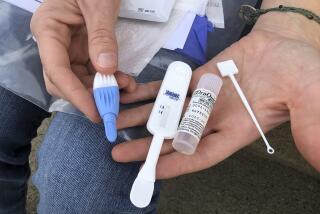AIDS Care Costs Overstated, Says Rand Study
Medical care for AIDS patients and HIV-positive people is not nearly the financial drain on the U.S. health care system that many claim it is, according to a major new study headed by researchers at the Rand Corp.
Such treatment costs the United States about $6.7 billion per year, less than 1% of all direct personal health care expenditures, the team reports in today’s New England Journal of Medicine.
That averages about $20,000 per patient, about a third of some previous estimates.
The tab is “not excessive,” the study said, considering that human immunodeficiency virus infections account for about 7% of the total years of life lost to all diseases nationally.
The findings suggest that the country could afford to treat all people who are infected with the virus.
“Our data explode the widespread belief that care for the HIV-infected is extraordinarily expensive,” said Dr. Samuel A. Bozzette of Rand and UC San Diego.
But the study also brings some bad news. As many as two-thirds of all HIV-positive people are not receiving treatment, often because they have not been tested and are not aware they have the disease. Fifty-nine percent of those being treated have full-blown AIDS. They are disproportionately male, black, unemployed, poor and lacking private health insurance.
The treated population essentially reflects the infected population at large, but may consist of more disadvantaged patients who did not receive early treatment to prevent progression to AIDS.
“This tells us that there are a large number of people in care, but also that there are a larger number who are HIV-infected and are not in care,” said Dr. Joseph F. O’Neill, associate administrator for AIDS of the federal Health Resources and Services Administration. “That’s very disturbing, because we can do so much clinically for people if they get in care.”
Up to 900,000 people in the United States are believed to be HIV-infected; about 15% of them have full-blown AIDS.
“To have such a large percentage of HIV-positive people who do not have access to health care is totally unacceptable,” added Rene Durazzo of the San Francisco AIDS Foundation. “It needs to be corrected.”
The results are from the ongoing HIV Cost and Service Utilization Study, designed to provide the first comprehensive picture on a national scale of who gets care for HIV, the kinds of health services used, the costs of these services and who pays. The study consortium will be issuing a series of reports through the next year or two.
Physicians throughout the country identified the 231,400 U.S. adults who received treatment for HIV or AIDS in January and February of 1996 and interviewed a representative sample of 2,864. They excluded people who received care in prisons, military facilities and emergency rooms.
Based upon this sample, they concluded that 292,000 to 372,000 HIV-positive people see a doctor at least once in any six-month period.
Among the findings:
* Seventy-seven percent of patients were men. About half were white, a third African American and one-sixth Latino. Women were more likely than men to be young, black, less educated, unemployed, impoverished and underinsured, but they were also less likely to have AIDS.
* About 85% of all adults with full-blown AIDS were receiving treatment.
* About 30% of patients received care at major teaching hospitals, the rest from office-based physicians and community hospitals and clinics. About 20% were hospitalized at least once during the six months before the interview, and their stays accounted for about 1% of all hospital days.
* Hospital care accounted for 43% of patients’ direct medical costs, drugs for 39%, emergency department care for 2%, and other costs 15%.
* Twenty-nine percent of HIV patients depend exclusively on Medicaid--three times the proportion of Medicaid patients in the general population. Medicaid is a government health-insurance program for poor people. Nearly a fifth of the patient population had coverage through Medicare, the federal insurance program for the elderly and disabled.
The $20,000-per-year cost of treatment was a surprise to the AIDS Foundation’s Durazzo.
“We have estimates of up to $100,000 per year for good care,” he said. The finding may mean that many or most people are not getting the best care available, he said, a point echoed by Bozzette.
“It would cost somewhat more to give them better care,” Bozzette said, “but how much more is not clear.” Many of those increased costs, he noted, will be offset by declining hospitalization rates, increased employment among HIV-positive people and increased productivity.
In the nearly three years since the interviews were conducted, hospitalization rates have declined markedly, as have death rates, because of the increased use and effectiveness of new drug combinations, he noted. At the same time, the cost of these pharmaceuticals has risen dramatically. It is not clear whether falling hospitalization rates and rising drug costs have balanced each other out.
In an editorial in the same issue, deputy editor Dr. Robert Steinbrook cautioned that even though deaths and hospitalizations from AIDS are down sharply, the incidence of new infections has not dropped and is in fact increasing among groups such as women, minorities and the rural poor. The number of new HIV patients, he warned, will continue to grow unless greater effort is spent on prevention.
More to Read
Sign up for Essential California
The most important California stories and recommendations in your inbox every morning.
You may occasionally receive promotional content from the Los Angeles Times.










